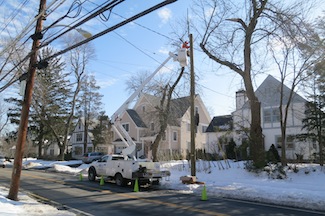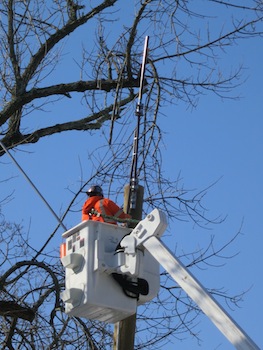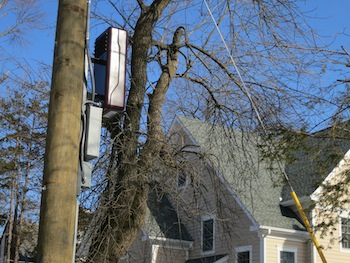Planning Board Ponders Response to Crown Castle Application to Install DAS in Scarsdale
- Tuesday, 12 February 2013 15:20
- Last Updated: Thursday, 14 February 2013 14:55
- Published: Tuesday, 12 February 2013 15:20
- Joanne Wallenstein
- Hits: 10887
 Though many residents were lobbying to fight Crown Castle's application to install a Distributed Antenna System (DAS) in Scarsdale, it looks now as if the Planning Board will work to preserve as much local control as possible but will not bar the carrier's entry to the Village.
Though many residents were lobbying to fight Crown Castle's application to install a Distributed Antenna System (DAS) in Scarsdale, it looks now as if the Planning Board will work to preserve as much local control as possible but will not bar the carrier's entry to the Village.
The Planning Board held a work session at Village Hall on 4/11 to review information from an attorney and an engineer and to get feedback from concerned residents.
As a result of the NextG (now Crown Castle) application to set up 15 nodes in Scarsdale, the Planning  Board retained the services of telecommunications law expert Joseph Van Eaton of Best, Best and Krieger and Lee Afflerbach of the engineering firm CTC Technology and Energy. Both have advised other municipalities who installed DAS systems.
Board retained the services of telecommunications law expert Joseph Van Eaton of Best, Best and Krieger and Lee Afflerbach of the engineering firm CTC Technology and Energy. Both have advised other municipalities who installed DAS systems.
Both experts concurred that DAS is here to stay in that it fills gaps in voice coverage, precludes the need for more large antennas, and allows for better delivery of broadband. Their advice appeared to be to draft laws that balance the rights of residents while heading off a legal challenge from Crown Castle.
In a similar fight in Greenburgh, the Greenburgh Town Board rejected Next G's proposal to install 20 antennas in residential areas only to be sued in federal court by the telecommunications company. Last July, in an effort to "preserve suburban character, aesthetics and property values," the Town Board turned down the NextG application. They concluded that NextG has failed to prove that its cell phone antennas was "needed to provide coverage to an area of unincorporated Greenburgh that currently has inadequate coverage." They also questioned the size requirements for the equipment and said it did "not meet the standard of minimal intrusiveness." They argued, "Did Next G prove that its facility "is the minimum height necessary to provide the coverage? We think not!"
 However it didn't end there. In August, 2012 the telecommunications company Crown Castle (under the name NextG Networks) filed a suit against the Town of Greenburgh, accusing town officials of creating roadblocks during the application process, keeping the company from installing their antennas and providing its services. Their lawsuit charges that the Town unreasonably delayed the company's application, which they filed in November of 2009.
However it didn't end there. In August, 2012 the telecommunications company Crown Castle (under the name NextG Networks) filed a suit against the Town of Greenburgh, accusing town officials of creating roadblocks during the application process, keeping the company from installing their antennas and providing its services. Their lawsuit charges that the Town unreasonably delayed the company's application, which they filed in November of 2009.
Therefore, in his presentation to the Scarsdale Planning Board on 4/11, Van Eaton briefed the group on the law and highlighted issues to consider when revising our zoning code, which now requires that the antennas be a minimum of 350 feet from a residence.
He explained that federal law mandates the following:
- Removals of barriers to entry that prohibit telecommunications companies from providing service
- Non-discriminatory treatment of one carrier over another
- Local control of land use-- however, siting decisions regarding personal wireless service facilities must meet federal standards. i.e. is service necessary to close a significant gap in service?
- A local government may not deny any eligible facilities request for a modification of an existing wireless tower or base station that does not substantially change the physical dimensions of such tower or base station
- Localities cannot make zoning decisions based on concerns about the health hazards of radio frequency (RF) as long as the FCC allows it
- Localities must act on an application within a reasonable period of time
Eaton suggested that the Planning Board consider whether the system is necessary, whether it would fill gaps in service and if it could be located in other places then on utility poles in the Village right of way. He also suggested the Board determine if Crown Castle could place their antennas on existing towers.
gaps in service and if it could be located in other places then on utility poles in the Village right of way. He also suggested the Board determine if Crown Castle could place their antennas on existing towers.
He ended by leaving the Planning Board with the following recommendations:
- Make policy choices with federal law in mind, but also considering how to preserve community property values, and protect the public interest.
- Maintain and revise local ordinances in light of federal requirements, and in light of possibility that new regulations will be developed from time to time
- Protect local values is possible; conflict can be avoided if DAS providers are willing to work with community
And also posed the following questions:
- Does the Village want to share its light poles?
- Does the Village allow ancillary equipment above ground (does it matter if the area is residential)?
- Is it better to have a lot of small antennas or a few larger antennas?
- If the Village allows any single user on its proprietary property, will it be required to lease to others and allow collocation?
- If the Village allows DAS on ground that it is unintrusive, how will collocation be addressed? What if multiple providers wish to build?
- How do you address community concerns about RF?
See a presentation from Van Eaton here:
Afflerbach then made his presentation to the group, explaining the DAS is a series of antennas placed in a strategic location and connected to a central system. In most cases they are connected to existing poles or structures in the right of way and allow for better cell coverage of challenging terrains. In his view, the large cell towers are going to fill up quickly, and DAS offers the best way to improve service.
He suggested that the Village look at other structures as possible sites for DAS antennas and did a survey of the Village. Rather than place the antennas on existing utility poles, Afflerbach came up wit the following alternative locations:
- Village incinerator smoke stack on Secor Road
- The top of Freightway Garage
- The church cupola at 1 Heathcote Road
- The communications tower at the Public Safety Building on the Post Road
- The cell tower on the Hutchinson River Parkway
- The train stations and the pipeline
Since the technology is changing rapidly he also advised the Board to grant short term licenses to the telecommunications companies so that the Board could reconsider their options every few years in light of new developments. Read the full report here:
About 15 residents were on hand to pose questions and make requests:
Marjorie Rosenblatt wanted to know what could be done to prevent more companies for making applications and crowding our streets with wires and equipment. Deb Pekarek asked if the equipment could be installed underground rather than wired onto poles. Carrie Fishman asked whether the water tower on Garden Road could be used to hold an antenna.
David Polsky told the Board to consider the rights of residents on smaller lots where the placement of an antenna could be as little as 10 feet from their windows. Natasha Rose of Ridgecrest East where Crown Castle has proposed to site one of the antennas said, "How are we discriminating against Crown Castle if we say no to everyone?" Jim Rose of Ridgecrest East said that he could already see the communications tower at the Public Safety Building from his back window and now feared he would see a DAS antenna out of his front window. He asked the Planning Board to consider provisions to mandate a minimum distance between towers to prevent one home from being unfairly impacted.
Jeff Berman asked about potential revenues from the antennas and was told that Crown Castle could rent these locations out to three carriers who would pay $100,000 per year per location. He suggested the Village build these ourselves. He also asked how much Scarsdale would receive from the installation of the DAS antennas and the answer was nothing. Wendy Lee asked the Board to consider property values, saying, "Are you going to buy a house with a DAS system outside?"
Rosenblatt spoke again, saying, "If we took a poll and found out that no one was going to sign up, would that put an end to it?" Jim Carforo said, "What's the downside of placing the antennas in a vault underground?" He also asked the Board to make the first draft of the proposed code public so that residents would have the chance to review it.
Planning Board Chairman Jane Veron ended the session by stating the Board's next steps will be to outline different policy options that would maximize Scarsdale's regulatory authority and to examine what other municipalities are doing.
No timetable was given for the next meeting.
Residents filed out of the meeting with a deep sense of irony about the issue:
- None of the residents in the room felt they needed better cell service
- No one wanted additional equipment placed on already strained utility poles
- Some feared cancer risks from radio frequency emissions near their homes
- Others worried about property value losses in DAS locations
- The Village would not realize any financial gain from allowing the installation
Yet with a sense of helplessness they acknowledged that a Federal statute prevents the Planning Board and ultimately the Board of Trustees from denying Crown Castle access to the village. Puzzling indeed.
Here is a list of the locations of the 15 nodes originally proposed in Scarsdale:
- 181 Fox Meadow Road
- 1 Ogden Road
- 21 Autenrieth Road
- 149 Lee Road
- 252 Grand Boulevard
- 28 Heathcote Road
- 17 Heathcote Road
- 12 Ross Road
- 54 Claremont Road
- 12 Ridgecrest East
- 7 Sycamore Road
- 11 Wynmor Road
- 109 Mamaroneck Road
- 4 Drake Road
- 81 Brookby Road
Addendum: Just two days later, without any notification to residents, a DAS antenna was installed on Palmer Avenue, directly in front of a house at 60 Palmer. The owner had not been notified, and according to a witness the man was surprised and dismayed.
Calls to the Village revealed that Palmer Avenue is a state road and therefore NYS owns the right of way. Even though local zoning code precludes the installation of an antenna less than 350 feet from a residence, state law permits the installation and supersedes local law. Do residents have the right to notification and does the Village have any recourse?
We called Village Planner Elizabeth Marrinan and Village Attorney Wayne Essanason with our questions and the Village is going to verify who installed the antenna and look into what, if anything, can be done. The Village also believes that more antennas were installed on the Post Road and will investigate those as well. Here are pictures of the installation on Palmer Avenue courtesy of Jon Thaler.










